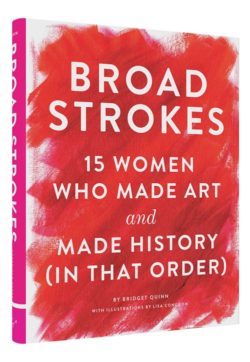
Author Bridget Quinn begins Broad Strokes with a memory of an encounter with a particular painting by a woman artist. It’s a powerful approach. Over the two decades when I taught courses about women artists, I saw many students experience the jolt of recognition when they saw themselves in art (or the lives of artists) from distant countries and long ago centuries. Artist Judy Chicago has said that, upon seeing Judith Leyster’s self-portrait for the first time, she felt she was seeing her own identity across the centuries. We can learn about art, and more, by studying the artists in this book.
The first artist Quinn introduces is Baroque painter Artemisia Gentileschi, the equal of any of the Old Masters. She is our Old Mistress. Artemisia achieved greatness despite the fact that she was raped by her art instructor at age 17, then put on trial (to prove her innocence) which involved driving screws through her thumbs. Not all women artists have been tortured, but they’ve all faced obstacles that male artists never encounter.
- Marriage for men, for instance, has not meant carrying and delivering a baby every year (a distinct possibility in the years before birth control). Are we really surprised to learn that Judith Leyster quit painting after having five children? Or that Rosa Bonheur determined never to marry after seeing her own mother work herself to death? And Paula Modersohn-Becker represents many other artists who died during or after childbirth (Eva Gonzalès comes to mind).
- Another impediment for women artists has been exclusion from the art establishment. Today, women aren’t prohibited from attending art schools or submitting work for official exhibitions. Why then does work by women comprise only 30% of museum collections and gallery shows, on average?
- Misattribution has also been an issue for women. Only her distinctive signature, discovered when paintings thought to be by Franz Hals were cleaned, restored credit to Judith Leyster for the majority of her oeuvre. Marie Denis Villier’s “Charlotte du Val d’Ognes” was attributed to Jacques-Louis David until 1977. It’s worth noting that these two women were mistaken for the greatest artists of their times!
- Trumped up rivalries between artists pitted women against one another, reflecting the notion that a woman artist was such a novelty that there could only be one at a time. Adélaïde Labille-Guiard and Elisabeth Vigée-Lebrun, both successful artists in 18th c. France, were set up as competitors. Decide for yourself whether one of these artists was inferior to the other.
Women communicate by telling each other stories about our lives. Throughout the book, in addition to telling artists’ stories, Quinn generously shares her own personal experiences of being affected by art and artists–how the work of Paula Modersohn-Becker embodied her fears about the impossibility of being both a mother an artist, or how she saw Edmonia Lewis’s vibrant sculptures of Native American subjects resonate with her Native half-sister.
The author’s informal, chatty writing style is appealing, but she also slides effortlessly into the lyrical as in this description of Alice Neel’s self-portrait, painted in old age:
Her body is a fallen landscape of battles gone by, her broad, distended belly rests across flaccid thighs while large, fleshy breasts dangle almost as low. Neel gave birth to four children, and it shows.
The artists in Broad Strokes stand for hundreds-thousands-who knows how many other women who have created works of art. The question is not, “Why have there been no great women artists?” but rather–considering their circumstances–“How have there been so many great women artists?”
May I suggest Broad Strokes, Volume II, as accessible and conversational as this book, about lesser-known women artists? And please be sure to include more delightful portraits by illustrator Lisa Congdon!
